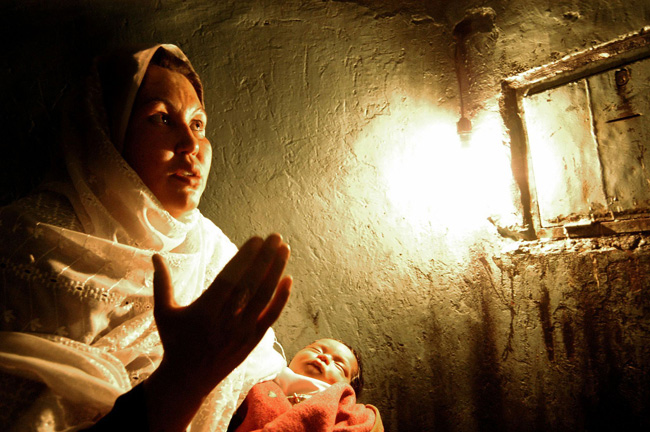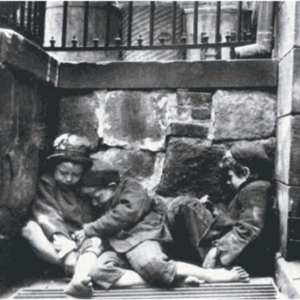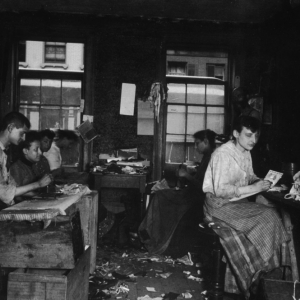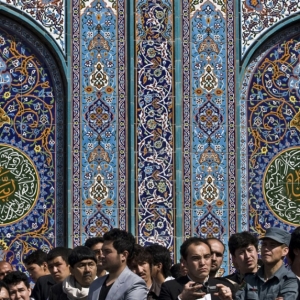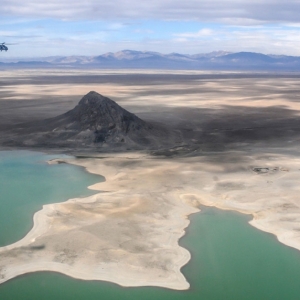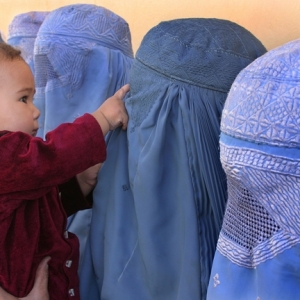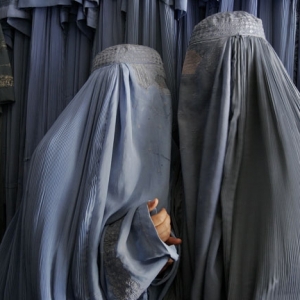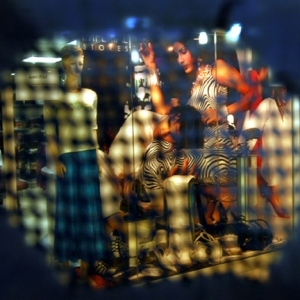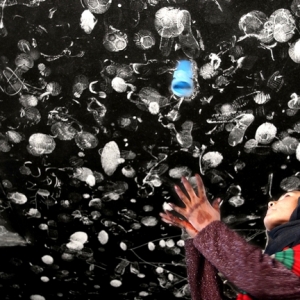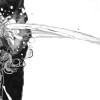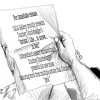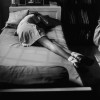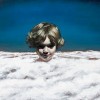“One half of the world does not know how the other half lives.”
It was these words, by writer François Rabelais, which inspired one of the earliest and most alarming photographic collections. Jacob Riis’ How the Other Half Lives: Studies Among the Tenements of New York exposed the squalid conditions of New York City’s slums at the end of the nineteenth century.
Riis’ stark, monochrome images were a demonstration of an impoverished world, shown to the city’s bourgeois population – many of whom were previously ignorant to the gruesome suffering existing mere metres from their own front doors. Candid images of blackened faces peering despairingly from fetid tenement rooms; barefooted children lying heaped in rancid gutters, and noxious sweatshops framing figures of pitiful labourers graphically exhibited New York’s poverty in a format unable to be ignored.
Photography’s potent ability to communicate lies in its visceral, instantaneous nature. Roland Barthes saw the photograph as “a message without a code” and it’s this directness between image and impact that affects photography as a swift, succinct catalyst for social change. Riis’ photography cemented visual images as tools for activism with his collection leading to a decade of major reformation in New York’s Lower East Side. Over a century on, the power of visual images still holds strong. Today the number of photographers is continually increasing, building on a revolutionised media platform – the internet – which allows us to share images from all over the globe at a pace and volume never before experienced. A proliferation of images has allowed free speech for masses at the click of a button, while easy access to photographs depicting scenes from around the globe is a feature of our media-orientated society.
For many living in Afghanistan, however, such freedoms are entirely nonexistent. During the Taliban’s rule of the country from 1996 to 2001 photography was banned: the act of taking a picture or carrying a camera, a crime. Even photographic advertisements were altered and restricted. Upon the arrival of international troops and the upending of Taliban leaders, press restrictions were gradually relaxed, allowing local and private media to grow. Relishing this new found freedom, the number of photographers soared, and the focus of Afghan photography changed from the capturing of war-torn landscapes to the portrayal of local culture and daily life. The Afghan Photography Network (APN) aims to raise awareness of Afghan photography, allowing international audiences to see Afghanistan through the eyes of its own creatives. Their initiative is open to all Afghani photographers, agencies and institutions, aiming to respond to the industry’s significant advances within such a concentrated period.
The photographers associated with APN all display highly divergent perspectives in regards to photographic technique and subject. Their views on the future of free speech in Afghanistan are also disparate and conflicting. One of these pioneering photographers is Farzana Wahidy. Wahidy is part of a rare collective of female Afghan photographers. This adds the problem of gender boundaries to her struggle to carve out a space for free speech in a country where, in some parts of the country, women are disbanded from school. In interviews, Wahidy has often explained the great need for Afghan female photographers in order to portray the country in its broadest sense.
Inevitably, war is a major issue within Wahidy’s photography. Yet as a woman, she is able to gain access to intimate and concealed aspects of Afghanistan’s female society, ranging from burqa shopping to female prostitution. Wahidy’s work fastidiously handles the boundary between art and activism. Her image of a woman feeding pigeons in Mazar-e Sharif, shows birds cascading through a sheer blue sky, their flurries of feathers melding with the clouds while the woman, clad in a brilliant white burqa, stands as stoic as the pillars of the Blue Mosque behind her. In another, a trio of Afghani women battle through a dusty breeze, their uniform blue burqas billowing and rippling; only their ankles clad in dainty lace and metallic shoes disclose their personalities.
More obvious cries for social change hit home in Wahidy’s portraits of women’s hands, scabbed, bloodied and raw; naked bodies knotted with rope-like burns are harrowing evidence of self-immolation. Wahidy states this is “often seen by women as the only way to escape a life of poverty and domestic violence.” Her photograph, through the burqa’s close-webbed eye net, makes for arresting viewing. Our obscured vision gives an oppressive confinement uneasily contrasted against the barely discernible mannequin with fair, western features and the advertising featuring an alluring Asian beauty clad in erotic animal print.
Despite these probing and alarming scenes Wahidy remarks, “I try to show the bigger image, not just that we have problems. I try to show normal daily life.” Further pictures show a girl standing over a rustic cooking pot, stirring her supper while blowing a huge bubble of pink gum and a teenager throwing up her shoes to a ceiling peppered with white foot prints. Here, Wahidy illustrates the normality of Afghan life – the pleasures of childhood and adolescent imagination universally present in our world.
“Photographs really are experience captured,” stated Susan Sontag, “and the camera is the ideal arm of consciousness in its acquisitive mode.” Wahidy uses the camera to such an advantage. Her arresting insistence that we should look, learn and act on these images forces them into our conscience with artistic prowess. Wahidy argues for the necessity of local photography in a country shrouded with conservative codes and restrictions. Local photographers who are able to access people and places denied to foreign media are necessary to gain a nuanced portrait of the country. It is the voice of a people unveiling their society to an international audience.
Additionally, Wahidy observes that “over 90 per cent of Afghans are illiterate, so they cannot read to get information about their country and the world.” In a climate where the majority of citizens gain their news from looking at pictures, photography is a vital instrument for Afghans to perceive reality. The need for Afghan photography is imperative. By unveiling the reality of Afghani life, photography is a vital tool for the development of democracy and autonomy, for verifying and limiting those in power and for the promotion of social and political change.
However, the future of Afghan visual art remains uncertain and the platforms grafted by local photographers lie in jeopardy. At present Afghanistan stands as one of the most occluded and convoluted information environments. With NATO forces and the Afghan government battling to gain dominant media power, divisions between propaganda, intelligence, and art are vague. As international forces prepare to leave the country, its defence, politics, and art will be left solely in the hands of the Afghan people. Risk of the Taliban regaining influence is growing ever more probable, whilst the climate of free speech, tentatively established within the past twelve years, is under threat and poised to undergo radical changes.
“Uncertainty right now in Afghanistan is pervasive,” states Mo Scapelli, a film maker documenting the work of Afghan photographers. “The desperation,” she says, of the photographers to keep their profession alive demonstrates “what free press means when you have to build it from nothing.” The most pressing threat, Scapelli has discovered through her work, is that Afghanistan will be “forgotten again” as the removal of international troops prompts a disinterest for reporting Afghani news.
Evident, is the essential need for Afghanistan’s local photographers to disclose their nation to both domestic and international audiences; proving that an absence of international activity does not mean their revealing and socially active art should be rendered obsolete. It is the task of local photographers to show the world “how the other half lives” through the eyes of its native people. Over one hundred years ago Riis’s black and white stills completely revolutionised one of the largest, cosmopolitan cities. With this same appreciation of what the visual image can achieve we must follow this legacy. We must continue to support Afghanistan as its photography not only becomes an insight into a distant yet fascinating culture, but also a vehicle for revolution.
